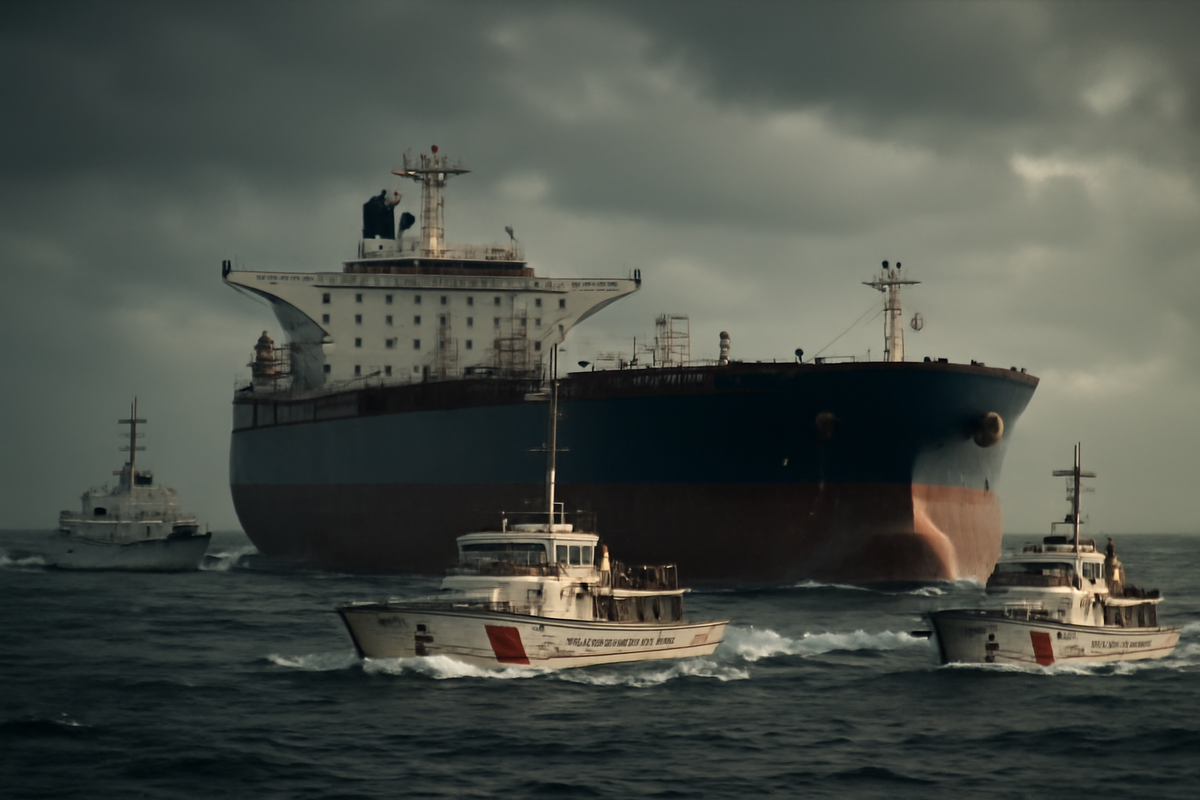Global Oil Prices Spike After Gulf Tanker Incident : Market Volatility and Supply Fears
Oil prices skyrocketed after a Gulf tanker incident disrupted critical shipping lanes, fueling fears of supply shortages. The crisis underscores the vulnerability of global trade to geopolitical tensions in one of the world’s most vital waterways.

A Sudden Shock at Sea
It began as just another trading day in the global oil markets until news broke that a tanker had been involved in a tense maritime incident in the Gulf. Within hours, oil prices spiked, traders scrambled, and governments convened emergency meetings.
The incident — involving a Liberian-flagged crude oil tanker and unidentified fast-approach vessels near the Strait of Hormuz has re-ignited concerns about the security of one of the world’s most vital maritime chokepoints. By midday, Brent crude surged past $96 per barrel, its sharpest single-day rise in months, while West Texas Intermediate (WTI) followed closely behind.
The tanker incident may have lasted only a few hours, but its economic aftershocks are now reverberating around the globe.
Why the Gulf Matters : A Chokepoint of Global Trade
To understand the market panic, you need to understand the geography. The Strait of Hormuz, a narrow waterway between Oman and Iran, is only about 33 kilometers wide at its narrowest point yet it carries roughly 20% of the world’s daily oil supply.
- Oil Flow: Around 17 million barrels per day pass through the strait, bound for markets in Asia, Europe, and beyond.
- Gas Shipments: Qatar’s liquefied natural gas (LNG) exports among the largest in the world also transit these waters.
Strategic Sensitivity: Any disruption here, even for a day, can cause ripple effects in energy markets from Singapore to San Francisco.

The Gulf has long been a hotspot for geopolitical tension. Past incidents from the 1980s “Tanker War” during the Iran–Iraq conflict to the 2019 series of tanker attacks have shown that even limited maritime skirmishes can send oil prices soaring.
What Happened This Time
While details are still emerging, initial reports from maritime security agencies suggest the following sequence:
- Early Morning Hours: The tanker was transiting eastbound through international waters in the Strait of Hormuz.
- Unidentified Approaches: Several small, fast boats possibly armed began trailing and circling the vessel.
- Evasive Maneuvers: The tanker’s captain issued distress calls and altered course to avoid boarding attempts.
- Naval Intervention: Coalition naval forces in the area responded, and the approaching vessels withdrew without shots fired.
- Aftermath: The tanker continued to its destination under escort, but insurance premiums for Gulf transits spiked immediately.
While no physical damage was reported, the message to the markets was clear: the Gulf remains a volatile zone where incidents can escalate quickly.
Market Reaction : A Spike Fueled by Fear
The oil market is famously sensitive to any sign of supply disruption. This incident came at a time when:
- Inventories were already tight due to OPEC+ production discipline.
- Demand forecasts for the second half of the year are bullish, particularly from recovering Asian economies.
- Geopolitical tensions in the Middle East are heightened due to unrelated regional conflicts.
Within hours of the news:
- Brent crude jumped from $92 to $96.4 per barrel.
- WTI rose from $88 to $91.8.
- Futures contracts saw increased volatility, with options traders pricing in further spikes.
Commodity analysts note that the spike was not just about lost barrels — it was about risk pricing. When traders sense a higher probability of future supply disruption, they bid up prices even if current supply remains unchanged.
The Domino Effect : More Than Just Oil
The impact of higher oil prices doesn’t stop at the pump. It triggers a chain reaction through the global economy:

1. Energy Costs Surge
Electricity generation in oil-dependent economies becomes more expensive, driving up utility bills for households and industries alike.
2. Inflation Pressures Mount
Higher fuel costs affect shipping, air travel, and manufacturing — feeding inflation at a time when many central banks are trying to cool price rises.
3. Currency Movements
Oil-importing countries see their currencies weaken as they spend more on energy imports, while oil exporters experience capital inflows.
4. Stock Market Volatility
Airlines, logistics firms, and manufacturing stocks often dip on high oil prices, while energy sector shares surge.
Geopolitics in the Background
The incident comes against a backdrop of shifting regional dynamics:
- Iran’s Naval Posture: Tehran has periodically used maritime pressure as leverage in diplomatic negotiations.
- U.S. and Allies’ Patrols: The U.S. Navy’s Fifth Fleet, along with European and regional partners, maintains a constant presence to deter such incidents.
- Ongoing Regional Tensions: Conflicts in neighboring zones from Yemen to Iraq add to the instability calculus.
Some analysts see this incident as part of a broader pattern of “gray zone” tactics actions designed to unsettle without triggering direct military retaliation.
The Insurance Angle : Risk Pricing in Real Time
While oil traders react to headlines, the shipping industry reacts to insurance rates. Immediately after the incident, war-risk premiums for tankers transiting the Gulf jumped by up to 20%.
For a supertanker carrying millions of barrels of crude, that can mean hundreds of thousands of dollars in extra costs costs that often get passed down the supply chain to consumers.
Historical Echoes : Lessons From Past Spikes
The current situation draws parallels to:
- 1987–1988 Tanker War: Multiple vessels attacked in the Gulf, prompting U.S. naval escorts and oil price volatility.
- 2019 Gulf Tanker Attacks: Several commercial ships damaged by mines or drone strikes, pushing Brent crude above $70.
- 2022 Russian Invasion of Ukraine: Global energy shock showing how geopolitical events can supercharge commodity markets.
In all these cases, even when physical supply losses were small, fear premiums added billions to market value.
Possible Scenarios Going Forward
1. Rapid De-escalation (Most Likely in Short Term)
Coalition patrols increase, diplomatic channels are engaged, and no further incidents occur. Prices may settle back within weeks.
2. Intermittent Incidents (Moderate Likelihood)
Small-scale harassment of tankers continues, keeping a “geopolitical risk tax” on oil prices for months.
3. Major Disruption (Low Likelihood, High Impact)
A successful attack or prolonged blockade causes actual supply loss, potentially sending Brent crude above $120 per barrel.
Global Energy Politics — Who Gains, Who Loses
- Winners: Oil-exporting nations like Saudi Arabia, UAE, and Russia benefit from higher prices.
- Losers: Energy-importing giants like India, Japan, and the EU face cost spikes.
- Neutral Players: Countries with diversified energy sources see smaller impacts but may still face inflationary pressures.
The Long View — Energy Security in a Risky World
This incident is a reminder that energy security is as much about geopolitics as geology. Even in an era of renewables, oil remains the lifeblood of the global economy. And as long as critical supplies flow through politically tense chokepoints, markets will live with the shadow of disruption.
For governments, this means investing in:
- Strategic petroleum reserves
- Diversified supply chains
- Naval security cooperation
- Accelerated transition to non-oil energy sources
For businesses, it means building flexibility into supply contracts and pricing strategies.

Conclusion : The Thin Line Between Calm and Crisis
The Gulf tanker incident was resolved without casualties or environmental damage. But it was enough to send a clear message: the world’s oil supply chain is a fragile lifeline, vulnerable to the smallest spark in volatile waters.
In markets driven by perception as much as production, fear is a commodity and last week, it was in high demand.
As tankers continue to ply the narrow lanes of the Strait of Hormuz under heightened watch, traders, governments, and consumers will all be holding their breath. Because here, calm and crisis are always just a few nautical miles apart.
Sources:
- Reuters – “Oil prices jump after Gulf tanker incident”
- Bloomberg – “Energy markets react to Strait of Hormuz disruption”
- Al Jazeera – “Tanker seizure raises shipping security fears”
- Financial Times – “Global crude markets shaken by Gulf tensions”
- U.S. Energy Information Administration (EIA) – “Oil market overview and price reports”




